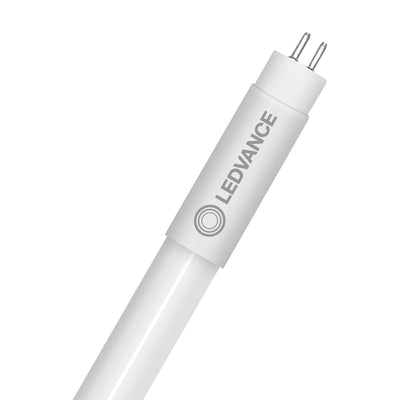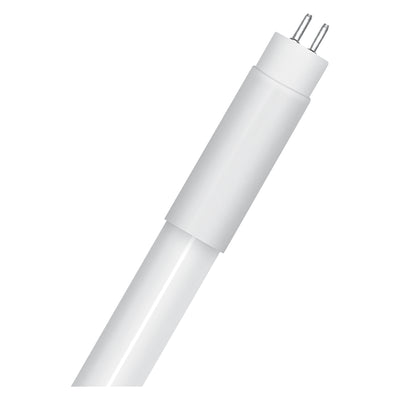
TL T5 85 cm
T5 fluorescent tubes with a length of approximately 85 centimeters are commonly found in older fixtures, often in offices, shops, and industrial environments. These slim fluorescent lamps, recognized by their G5 socket and 16 mm diameter, are known for their compact size and efficient light output.
Switching to LED T5 Lighting: Practical Advantages
Replacing traditional 85 cm T5 fluorescent tubes with LED versions offers a number of significant benefits, both technically and financially. These advantages make the switch attractive for facility managers and installers:
- Significant Energy Savings: LED T5 tubes use up to 60% less energy than their fluorescent counterparts, while delivering the same or even better light output. This directly results in lower operating costs.
- Longer Lifespan: LED technology is known for its long service life. Whereas a traditional T5 needs to be replaced after approximately 15,000 to 20,000 hours of operation, an LED T5 tube easily lasts 50,000 hours or longer. This means less maintenance and less frequent lamp replacements.
- Improved Light Quality: LED T5 tubes provide stable, flicker-free lighting, contributing to a more comfortable work environment and less eye strain. In addition, the color rendering index (CRI) is often higher, making colors appear more natural.
- More Environmentally Friendly: Unlike traditional fluorescent tubes, LED versions contain no harmful mercury. This makes them safer to use and easier to recycle, contributing to more sustainable business operations.
- Instant Brightness: LED tubes provide full light output immediately after switching on, with no warm-up time.
Finding a Suitable LED Replacement for 85 cm T5 Fluorescent Tubes
The term '85 cm T5 fluorescent tube' generally refers to a specific length corresponding to certain wattages in original T5 High Efficiency (HE) or High Output (HO) tubes. When replacing, it is important to choose the right LED version that matches the existing situation in length and light intensity.
| Type of Original T5 Tube | Typical Length (mm) | Usual Wattage | Recommended LED Alternative |
|---|---|---|---|
| T5 HE (High Efficiency) | 849 | 21W or 28W | LED T5 tube with corresponding lumen output and a length of approximately 849mm. |
| T5 HO (High Output) | 849 | 35W or 39W | LED T5 tube with higher lumen output, matching the 849mm length. |
When purchasing an LED replacement, always check the wattage the LED tube is designed to replace, as well as the actual length. These are usually clearly stated in the product specifications.
Installing T5 LED Tubes: Points of Attention for the Installer
For technicians, it is essential to know the best way to switch to LED T5 tubes, depending on the type of fixture already installed. T5 fixtures use an electronic ballast (HF ballast), which differs from T8 fixtures that can also function with a conventional (EM) ballast.
Check the Ballast
Most T5 LED tubes are designed to work directly with the existing electronic ballast (HF ballast) in the fixture (Type A LED tubes). This makes installation relatively straightforward, similar to replacing an old lamp:
- Ensure the fixture is disconnected from the power supply.
- Remove the old T5 fluorescent tube from the sockets.
- Insert the new LED T5 tube into the sockets.
- Restore the power and check operation.
Always check the compatibility of the LED tube with the specific ballast in the fixture. Consult the product manual for the LED tube for guidance.
Direct Mains (Ballast Bypass)
Some T5 LED tubes are suitable for direct connection to mains power (Type B LED tubes), where the electronic ballast is removed from the fixture. This can result in slightly higher energy efficiency and eliminates the need to replace a ballast in the future. This method requires rewiring the fixture and is generally a task for a qualified electrician. There are 'single-ended' (power supplied to one end) and 'dual-ended' (power supplied to both ends) variants available; make sure to use the type required by the LED tube.
Technical Specifications for the T5 LED Tube
To make an informed decision when purchasing LED T5 tubes, it is important to consider other technical specifications in addition to length and wattage:
- Lumen Output: Indicates how much light the tube actually produces. Compare the lumen value to ensure sufficient brightness for your space.
- Light Color (Kelvin): The color temperature, expressed in Kelvin (K), affects the atmosphere. Warm white (approx. 3000K) creates a pleasant ambience, while cool white (approx. 4000K) or daylight white (approx. 6500K) is better suited for workspaces where concentration is important.
- Color Rendering Index (CRI): A CRI of 80 or higher means colors are rendered realistically, which is important in many applications.
- Dimmability: Not all LED T5 tubes are dimmable. If adjustable lighting is needed, look specifically for dimmable LED T5 tubes that are compatible with LED dimmers.
- Lifespan: Although LEDs have a long lifespan, there can be minor differences between products and brands. A longer lifespan (number of operating hours) means less frequent replacements.
Applications of T5 Lighting
T5 fluorescent tubes, and now the LED versions, are widely used in situations where uniform and efficient lighting over a large area is needed:
- Offices: For general workplace lighting, often in recessed or surface-mounted fixtures.
- Retail Stores: For general lighting and product illumination, especially in aisles and shelves.
- Schools and Educational Institutions: For lighting in classrooms and hallways.
- Warehouses and Production Areas: Where bright and consistent light contributes to safety and productivity.
- Public Buildings: Such as libraries, hospitals, and sports facilities.
Responsible Disposal of Old Fluorescent Tubes
Old T5 fluorescent lamps, like other fluorescent lights, contain a small amount of mercury. It is important not to throw them in with regular waste. Take them to a municipal collection point for small chemical waste or to special collection locations for lighting waste. This helps with proper recycling and prevents harmful substances from entering the environment.

